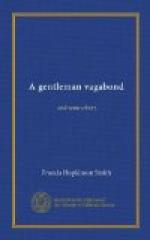I
I found the major standing in front of Delmonico’s, interviewing a large, bare-headed personage in brown cloth spotted with brass buttons. The major was in search of his very particular friend, Mr. John Hardy of Madison Square, and the personage in brown and brass was rather languidly indicating, by a limp and indecisive forefinger, a route through a section of the city which, correctly followed, would have landed the major in the East River.
I knew him by the peculiar slant of his slouch hat, the rosy glow of his face, and the way in which his trousers clung to the curves of his well-developed legs, and ended in a sprawl that half covered his shoes. I recognized, too, a carpet-bag, a ninety-nine-cent affair, an “occasion,” with galvanized iron clasps and paper-leather sides,—the kind opened with your thumb.
The major—or, to be more definite, Major Tom Slocomb of Pocomoke—was from one of the lower counties of the Chesapeake. He was supposed to own, as a gift from his dead wife, all that remained unmortgaged of a vast colonial estate on Crab Island in the bay, consisting of several thousand acres of land and water,—mostly water,—a manor house, once painted white, and a number of outbuildings in various stages of dilapidation and decay.
In his early penniless life he had migrated from his more northern native State, settled in the county, and, shortly after his arrival, had married the relict of the late lamented Major John Talbot of Pocomoke. This had been greatly to the surprise of many eminent Pocomokians, who boasted of the purity and antiquity of the Talbot blood, and who could not look on in silence, and see it degraded and diluted by an alliance with a “harf strainer or worse.” As one possible Talbot heir put it, “a picayune, low-down corncracker, suh, without blood or breedin’.”
The objections were well taken. So far as the ancestry of the Slocomb family was concerned, it was a trifle indefinite. It really could not be traced back farther than the day of the major’s arrival at Pocomoke, notwithstanding the major’s several claims that his ancestors came over in the Mayflower, that his grandfather fought with General Washington, and that his own early life had been spent on the James River. These statements, to thoughtful Pocomokians, seemed so conflicting and improbable, that his neighbors and acquaintances ascribed them either to that total disregard for salient facts which characterized the major’s speech, or to the vagaries of that rich and vivid imagination which had made his conquest of the widow so easy and complete.
Gradually, however, through the influence of his wife, and because of his own unruffled good-humor, the antipathy had worn away. As years sped on, no one, except the proudest and loftiest Pocomokian, would have cared to trace the Slocomb blood farther back than its graft upon the Talbot tree. Neither would the major. In fact, the brief honeymoon of five years left so profound an impression upon his after life, that, to use his own words, his birth and marriage had occurred at the identical moment,—he had never lived until then.




